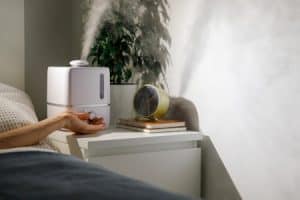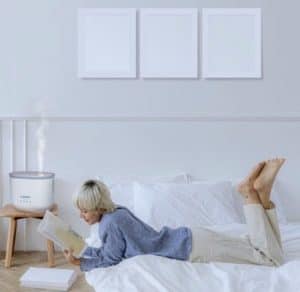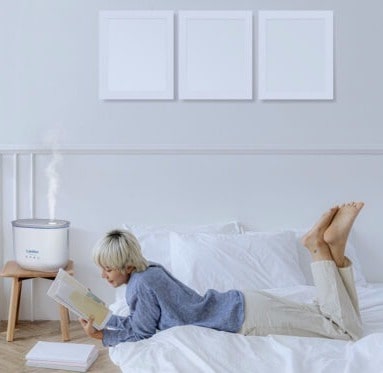People have a lot of buzzes and craze to buy air purifiers, air disinfectants, humidifiers, dehumidifiers, and other products that claim to enhance air quality. If you are among those many people who are figuring out what all of the crazes are about, you have come to the right place. In this article, we will demystify some truths about a Humidifier and understand if this device is a must-have at your home.
Let’s start by understanding what a Humidifier is. A humidifier is a simple device that helps add moisture to the air. It does this by releasing steam or water vapor in the air, increasing humidity’s moisture level in the air. When the air is dry, it causes the skin to break or crack, chapped lips, or dry throat. Some flu symptoms, the common cold, can also be eased with humidifiers.
Wondering how it can be used? Humidifiers are moisturizing agents that can relieve many symptoms of dryness in the body. If you suffer from dry skin, especially during winters, or sinus, dry and irritated throat, dry cough, chapped lips, a humidifier can help you the most. These are generally caused when the air is too dry at home. A humidifier can add the much-needed moisture in the air making these symptoms disappear as if they were never there. Most of these symptoms occur during winters. However, too much exposure to air conditioners during summers is another common reason.
Table of Contents
Where to Put a Humidifier
Once you have bought the humidifier, it is essential to find the ideal position for the humidifier. There are two key things to keep in mind when finding a place for the humidifier:
- It needs to be placed higher from the ground, i.e., two feet above the floor, on top of a table or cabinet. This is to ensure that one does not slip or knock the humidifier in case of any leaks. Some humidifiers switch off automatically if their tanks are not in the correct position.
- It should be easier to place a sheet or towel below the humidifier so that the water vapor does not drop directly onto the furniture. There can be accidents where the water tank leaks or spills during filling. A sheet or towel can come in handy in protecting the furniture in such situations.

Best Position for Humidifier
Finding the best position for the humidifier needs a little thinking. You can narrow down the positions by considering three things: Room size, furniture and obstructions, and airflow.
Size of the room: If a room is large, then the humidifier needs to be placed in the center so that the entire room can be covered. Also, the size of the humidifier needs to be considered.
Furniture and obstructions: Vicinity to the nearby objects also is a huge factor. Humidifiers add moisture to the air. Hence, any furniture damaged with excess moisture can’t be closer to the humidifier. There is always a risk of leakage; hence wooden furniture, and electronic equipment need to be away from the humidifier.
Air Flow: Humidifiers use air from the environment to evenly moisten the air. Any airflow restrictions will lead to moisture accumulating in one area.
Best Position for Humidifier in Bedroom
For a humidifier to give the benefits that you need while sleeping, it is important to place it in the proper position. If the room is small and you don’t have too many options to keep the humidifier, you can place it as far as possible from your face. If you have a larger bedroom, keep the humidifier about 3 feet from the bed. This distance will ensure that you don’t have to deal with hot water accidents while sleeping. It will also ensure that a noisy humidifier does not disturb your sleep. Finally, it ensures that the water vapor’s moisture is distributed equally throughout the room. Moist air in the room can help you breathe easily, but moisture right on your nose and mouth can become uncomfortable within minutes. No matter how sick you feel, keeping a humidifier at a good length away from the bed is recommended.

Should a Humidifier Be on the Floor or a Table?
Ideally, a humidifier should be placed on top of the table rather than the floor. This is straightforward; humidifiers have an internal tank filled with water. However, unintentionally, one may knock over the humidifier while using the bathroom or walking around the room in the dark; this can damage the humidifier and cause serious accidents. Therefore, a humidifier placed on the table that is not easily accessible and does not block the walking path is ideal.
When Should You Use a Humidifier in Your Home
If you live in a place where the humidity levels are low, the air is dry, or in a colder region, a humidifier is a must at your home. Regular use of humidifiers is not ideal if the energy costs are soaring, but humidifiers can be used while sleeping if dry air is causing you health troubles. Some people have a humidifier attached to their HVAC system to regulate the humidity levels at their homes. In many cases, doctors too recommend using a humidifier at home. Most of the reasons for using a humidifier are medical; however, if dry air makes your sleep uncomfortable, you can use a humidifier at home.
Special Considerations Based on Humidifier Type
The distance from your bed might also vary based on the type of humidifier you use:
Cool Mist Humidifiers
Cool mist humidifiers are the most popular for bedroom use because they are safer and ideal for continuous overnight operation. These should be placed at least a few feet from your bed to avoid creating damp spots.
Warm Mist Humidifiers
Warm mist humidifiers release heated water vapor, which can make them less suitable to place too close to your bed. Not only do they heat up, but the warm mist can make you feel overly warm if placed too close. Maintain a distance of 3 to 6 feet, and make sure the humidifier is out of reach to prevent accidental burns.
Ultrasonic Humidifiers
These types of humidifiers use ultrasonic vibrations to produce fine mist. Ultrasonic humidifiers are often very quiet and safe to use near the bed, though they should still maintain a few feet of distance to avoid direct exposure.
FAQ
Is it bad to sleep with a humidifier every night?
A humidifier only adds moisture to the air by turning water into vapors. Nothing else. Hence it is not harmful to your health in any way. Humidifiers are also recommended in the baby’s nursery to give the baby a comfortable sleep. Just make sure that the humidity level is not more than 30%. Otherwise, a humidifier can create excess moisture and make the room muggy. It is also important to maintain the humidifier to get all its benefits with daily use.
Can you put a humidifier in a corner?
Since the only thing humidifier uses to work is water, it is a cause of concern for growing mold after energy. While it is not ideal for placing humidifiers on top of cupboards or higher cabinets near the ceiling, they can be placed in the corner of the room. Just make sure there is enough gap between the wall behind and the humidifier so that any accidental spillage does not damage the wall. Also, placing it in the corner will ensure that the moisture is diffused properly throughout the room.
Final Word
Simple things like a humidifier that adds moisture to the air can help you live a healthy life during the day and sound asleep at night. It is tempting to use a humidifier after reading the benefits that it brings along. Still, one must also maintain the humidifier to ensure its optimum usage and long life. Cleaning the filters regularly, using distilled water, keeping it clean and away from any harm will ensure that your humidifier lasts long.


